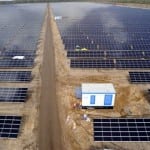Two large solar power projects—located more than 4,600 miles apart—recently came online in the U.S., providing service in Florida and Hawaii.
Duke Energy on Jan. 8 announced its 74.9-MW Hamilton Solar Power Plant was online. The installation in Jasper, Fla., is part of the company’s plan to build or acquire at least 700 MW of solar power in the state by year-end 2022.
On the same day, the Lawai Solar and Energy Storage Project in Lihue, Hawaii, was commissioned by the Kauai Island Utility Cooperative (KIUC). The facility began operating in December 2018. The project from AES Corp. is considered the world’s largest battery energy storage system (BESS) paired with solar generation. It combines 28 MW of solar photovoltaic generation capacity across a 150-acre site with a lithium-ion BESS of up to 100 MWh capacity.
The BESS is notable because it holds more energy than all but one other U.S. installation, a 120-MWh facility built by AES in Escondido, Calif., in 2017. Said AES CEO Andres Gluski: “All told, the new system will help Kauai top 60% renewables in the next five years. In the process, it will remove the annual cost and environmental impact of 3.5 million gallons of oil. The plant also avoids fossil fuels and herbicides used in traditional maintenance with 300 sheep on site to manage vegetation in an environmentally-friendly way.”
Duke Energy Plans More Solar and Battery Storage
Duke Energy broke ground for the Hamilton plant in July 2018, and the facility began producing power on Dec. 22, 2018. Duke Energy completed the project that was originally developed by Tradewind Energy Inc.
Catherine Stempien, state president for Duke Energy Florida (DEF), in a statement said, “Duke Energy solar projects bring the greatest amount of renewable energy on line for customers in the most efficient and economical way. Building solar power plants like Hamilton is part of our ongoing strategy to offer sustainable, diverse and smarter energy solutions that our customers have told us they value.”
Drone video of the Hamilton installation is available here.
DEF, which has about 100 MW of installed solar capacity in operation, plans to begin building a second 74.9-MW plant in Florida this year. The Columbia Solar Power Plant in Fort White, which will be developed by Core Solar, is expected to come online in March 2020.
Duke Energy also has said it will make “strategic, targeted investments in battery storage technology” in the coming years. It already has announced $500 million of battery storage projects in North and South Carolina that will come online over the next 15 years.
The company has increased its portfolio of renewable energy generation in its service territory in the southeastern U.S. in recent years, and announced its target of 700 MW in Florida in 2017. The company last year said it would continue to move away from coal-fired power plants as part of a decarbonization plan.
Kauai Embraces Renewables
The new Lawai plant could supply more than 10% of the island of Kauai’s power. Two other solar farms on the island, each about half the size of the Lawai facility, already produce much of the island’s electricity. Tesla funded a solar array that came online in 2017, and the Anahola solar project from REC Solar has operated since 2015.
“Now that the Lawai project is on line, as much as 40% of our evening peak power will be supplied by stored solar energy,” said KIUC President David Bissell on Tuesday, as he spoke at a ceremony to officially open the new plant. “I think it’s safe to say this is a unique achievement in the nation and possibly the world.”
The Lawai plant is located on land that formerly served as a sugar-growing operation. Power from the facility will be purchased by KIUC at 11 cents/kWh via a 25-year power purchase agreement.
KIUC, AES Distributed Energy, and the U.S. Department of Defense are partnering on a solar+storage project that will soon break ground on land that houses the Pacific Missile Range Facility (PMRF) in Kekaha. The PMRF facility will include a 19.3-MW solar array along with a 70-MWh BESS.
Said Bissell: “We expect the PMRF project to be online by the end of this year, and that will bring us well over 60% renewable [on the island]. Our strategic goal is 70% renewable by 2030. We’ll be substantially there a full 10 years early.”
—Darrell Proctor is a POWER associate editor (@DarrellProctor1, @POWERmagazine).









